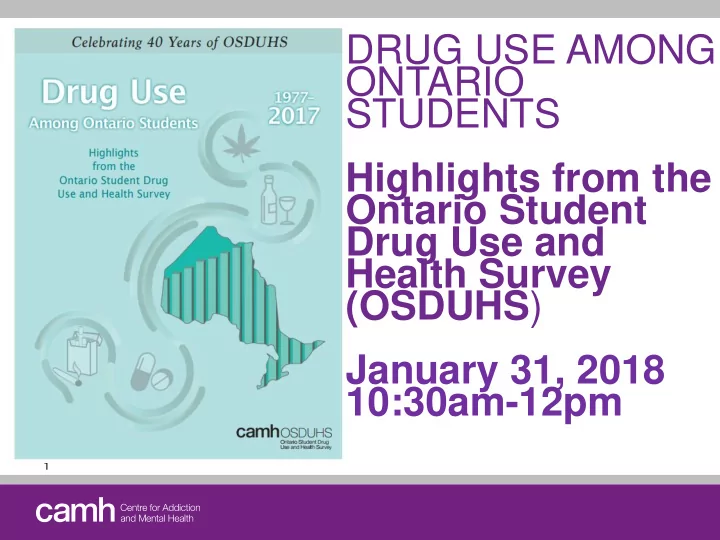

DRUG USE AMONG ONTARIO STUDENTS Highlights from the Ontario Student Drug Use and Health Survey (OSDUHS ) January 31, 2018 10:30am-12pm 1
About the Provincial System Support Program (PSSP) • Supports Ontario’s Comprehensive Mental Health and Addictions Strategy, through system interventions. • Provides capacity and expertise in: – knowledge exchange – information management – implementation – coaching – equity and engagement – evaluation 2
3
What is the Ontario Student Drug Use and Health Survey (OSDUHS)? • A repeated, cross-sectional, anonymous survey • Self-reported questionnaires • Grades 7 to 12 in Ontario’s publicly -funded schools • Schools are randomly selected with probability proportionate to school enrolment size • All students in a class with signed consent forms are eligible to participate • French questionnaires used in French schools 4
HAPPY 40 TH BIRTHDAY OSDUHS! 1977- 2017 • Conducted every two years since 1977 • Longest ongoing student survey in Canada and one of the longest in the world 5
Topics Explored • Drug use and related harm indicators • Family and school life • Drug perceptions • Substance use and injury • Mental and physical health indicators • Antisocial behaviours • Violence at school • Bullying (including cyberbullying) • Gambling and video gaming problems 6
About the 2017 Survey Participants: 11,435 students in 52 school boards 764 classes and grades 7-12 214 schools 7
Overview of Drug Use 8
Poll: In the past year, what were the 3 drugs Gr. 7- 12 students reported using the most? 9
Lifetime and Past Year Drug Use • Percentage of students reporting lifetime and past year drug use 10
Frequency of Drug Use (total sample)
Frequency of Drug Use (among users) 12
Significant Changes in the Past Year Drug Use 13
DRUG SPECIFIC HIGHLIGHTS 14
15
Past Year Alcohol Use
Alcohol • 16% students report getting drunk at least once in the past month • 17% (1 in 6) students report binge drinking • 14% (1 in 7) gr. 9-12 students report drinking hazardously or harmfully ( AUDIT screener) • Males and females are equally likely to drink alcohol and to drink hazardously or harmfully 17
18
E-Cigarettes, Waterpipes, Hookah • 11% ( ~ 80,800) gr. 7-12 students report using an e-cigarette in the last year • 2% use an e-cigarette daily • 6% gr. 7-12 students used a waterpipe at least once in the past year • Likelihood of e-cigarette and waterpipe/ hookah use increases with grade 19
20
Long-term cannabis use trends • Current cannabis use is significantly higher than low levels of use seen in the late 80’s and early 90’s Long-term cannabis use trends, 1977- 2017 21
22
Impaired Driving 23
Impaired Driving & Injury • 16% (1 in 6) gr. 7-12 students reported riding in a vehicle driven by someone who had been drinking • 8% (1 in 12) students reported being injured or someone else was injured because of their drinking 24
Cannabis Legalization • 35% gr. 7-12 students think cannabis should be legal for adults • 11% students say they will use the same amount of cannabis as they did before legalization • 8% say they will try cannabis • 4% say they will use cannabis more often post legalization 25
26
27
OTHER NOTABLE FINDINGS 28
Last year use of… Nonmedical Prescription Drugs • 2% of students used ADHD medication without a prescription Over-the-Counter (OTC) Drugs • 9% of students used OTC cough and cold medications to get high Caffeine & Energy Drinks 34% of students consumed an energy drink • 11% of students consumed coffee and/ • or caffeinated tea daily 29
Sex Differences Males are significantly more likely than females to use the following drugs: • Tobacco cigarettes • Electronic cigarettes • Waterpipes/ Hookahs • Smokeless tobacco • OTC cough/ cold medication • Energy drinks • Mushroom/ Mescaline • LSD 30
Regional Differences • Students in the North, West and East do not significantly differ from provincial averages and use measures • Students in the GTA are less likely to smoke tobacco cigarettes, use mushrooms and energy drinks • Students in the GTA are more likely to use inhalants and OTC cough or cold medications 31
First Time Use in the Last Year • Students today are initiating substance use at older ages than in the past. 32
Shifts in Substance Use • 44% (~332,000) gr. 7-12 students report using no drug at all during the past year • Past year abstinence significantly decreases with grade • Significant increasing trend in abstinence between 1999 and 2017 33
Drug Use Problems • 14% (1 in 7,~109,700) students report symptoms of a drug use problem (CRAFFT screener) • 0.6% (~3,800) gr. 9-12 students report that they have been in a treatment program during the past year due to alcohol and/ or drug use • 2% (~ 9,800) of gr. 9- 12 students report symptoms of cannabis dependence 34
Today’s Panel Dr. Robert Mann , Senior Scientist, Population Health and Community Transformation, Institute for Mental Health Policy Research, CAMH, and Associate Professor, Dalla Lana School of Public Health, University of Toronto Dr. Hayley Hamilton , Research Scientist, Population Health and Community Transformation, Institute for Mental Health Policy Research, CAMH Joanna Seel , Social Worker, Youth Concurrent Disorders Services, CAMH 35
Positive Findings 36
Some Concerns 37
38
Thank you! To access the OSDUHS report, please go to: www.camh.ca/research/osduhs For more information, please contact: Tamar Meyer Supervisor Knowledge Exchange, Provincial System Support Program tamar.meyer@camh.ca Angela Boak , Research Coordinator and Analyst Institute for Mental Health Policy Research angela.boak@camh.ca 39
Recommend
More recommend